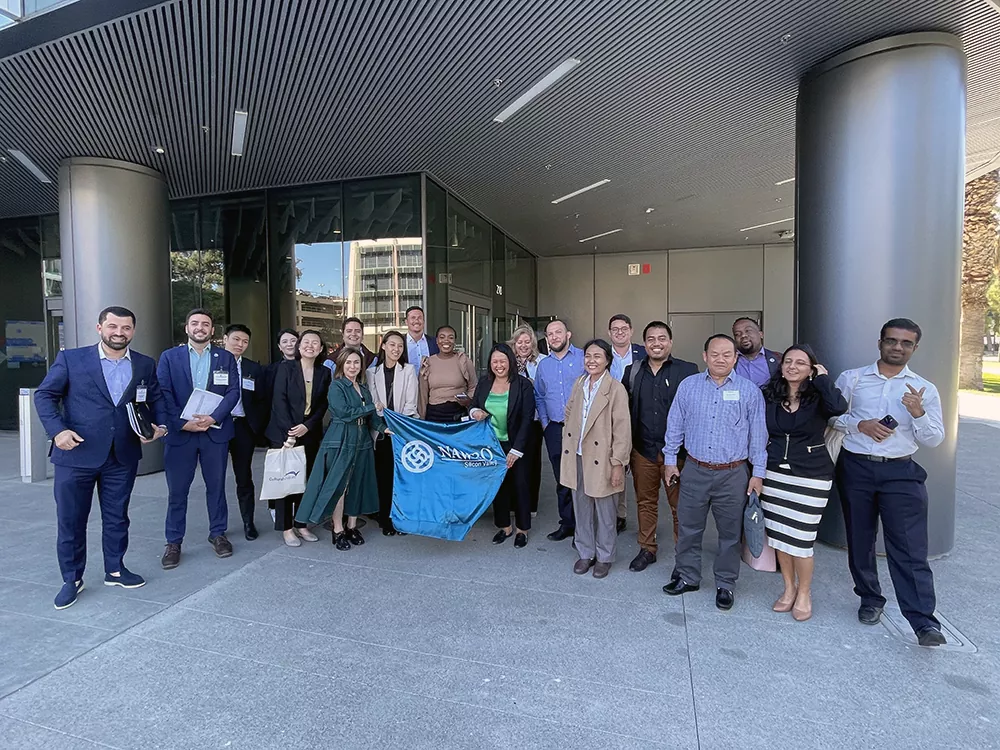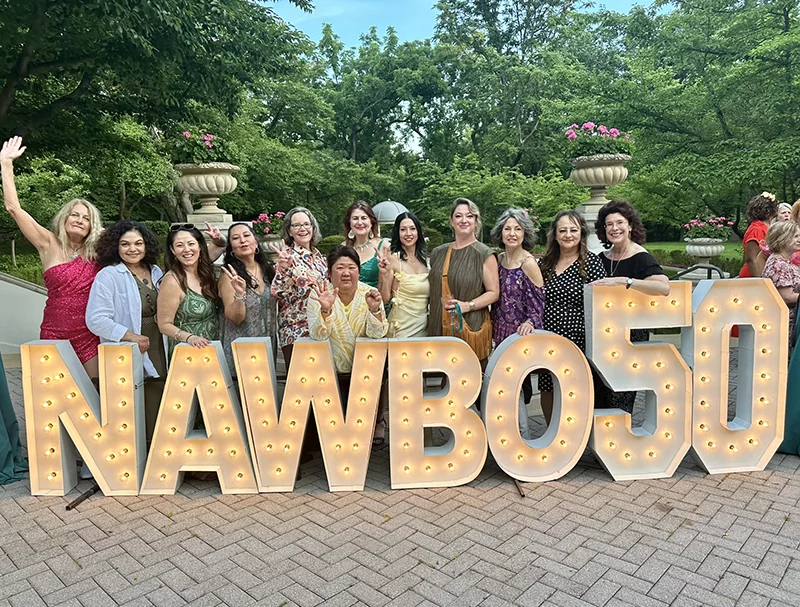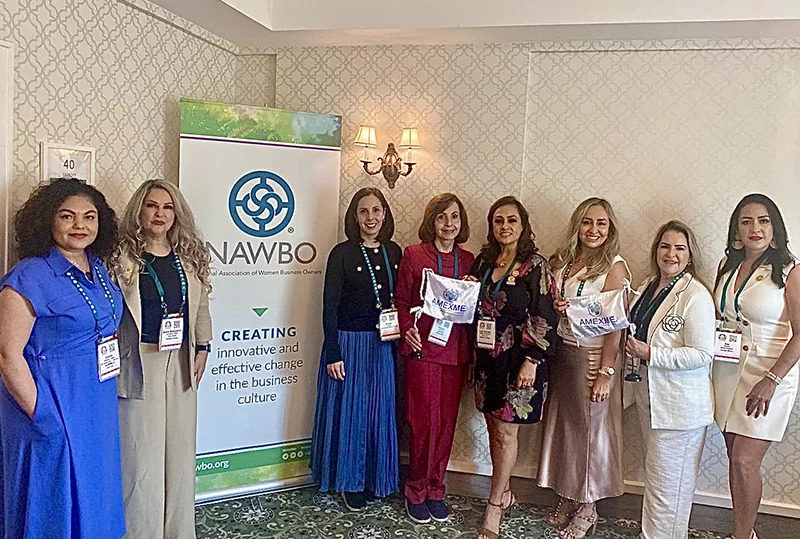Corporate Partner Corner
Special benefits and offers from our corporate partners for NAWBO members.
President’s Message | November 2025
Dear NAWBO Sisters and Community Leaders,
We are off and running this season with incredible momentum and great news! Our members continue to make strides in their businesses—reaching milestones they once only imagined. It’s inspiring to see how women across our chapter are leading with courage, creativity, and community.
Member Milestones Worth Celebrating
- Dr. Mary Mardkhe – Nominated for a Stevie Award for her groundbreaking work as a chemist turned entrepreneur.
- Dr. Meng Yang – Presented at an international conference overseas, IAAP Congress in Zurich, in the field of psychology.
- Paulina Tarnopolsky – Reached her two-year anniversary and achieved an impressive seven-figure revenue milestone.
- Angela Laines – Marked two successful years in business, continuing to help brands grow through creativity and design, and is on track to supersede her salary in Corporate America.
- Leslie Murdock – Completed her Leverage for Leaders Executive Coaching Program with Karen Cappello, MCC, within her first month of being a NAWBO Silicon Valley Member.
- Robin Fisher – Certified Women Business Enterprise (CWBE) through NAWBO Institute and Women Owned Small Business (WOSB) Certification through the federal Small Business Administration.
- Laura Salgado – Certified Women Business Enterprise (CWBE) through NAWBO Institute Certificate and her products are listed on Amazon and Walmart.
- Your Name – I want to make sure we’re celebrating more of our members because we have so much to honor and be proud of.
Leadership & Wellness Retreat Recap
Last month, we hosted our NAWBO Leadership and Wellness Retreat with over 40 guests, including leaders in technology, finance, philanthropy, law, business, and non-profit. The day centered on self-care, personal reflection, and strategic growth. It was a powerful reminder that success begins with investing in ourselves.
A heartfelt thank-you to our generous partners—the 49ers Foundation, San Jose Earthquakes, Face Foundrie Emeryville, Stirbar Labs, Coach Madison, and Tisha’s Company—for supporting our auction and making the event unforgettable.
Chapter Wins and Upcoming Events
- Women Business Certification in Spanish: NAWBO Silicon Valley is the chapter that created WBE certification in Spanish, expanding access for Latina entrepreneurs.
- WBE Success Stories: Two members recently submitted their certification applications through the NAWBO Certification Institute, opening doors to procurement and partnership opportunities.
- Business Summit – Thursday. October 23rd: Join us for a full day of insight on AI, access to capital, and financial planning for wealth creation.
- Networking Dinner – Thursday, November 13, 2025 at Lazy Dog in Cupertino: A relaxed evening to connect, collaborate, and build community.
- Co-Hosted Holiday Celebration – December 3rd: We’re partnering with the Silicon Valley Chamber of Commerce at the Triton Museum for a festive event celebrating women in business with 125 guests in attendance.
- Corporate Partner Luncheon — This will be hosted in January to honor and appreciate our Corporate Partners for their support for Women in Business & Entrepreneurship.
Here’s Our Ask
We’re growing—and we’d love your help!
- Volunteer: Join one of our committees and help shape programs, partnerships, and upcoming events.
- Present: Apply to present to NAWBO Silicon Valley—a $250 donation supports our chapter while giving you a platform to share your expertise.
- Fundraising Support: We’re ramping up our raffle and fundraising efforts—if you or a friend can donate a product, service, or experience, we’d love to include it.
- Share Your Wins: We love celebrating our members’ achievements! Submit your milestones, awards, or exciting news so we can feature you in our next newsletter and events.
Together, we’re creating a movement of women who lead boldly, collaborate generously, and celebrate one another every step of the way.
In partnership,
 Leena Mendoza, MS, ACC
Leena Mendoza, MS, ACC
President, NAWBO Silicon Valley
leena@leenamendoza.com
www.leenamendoza.com
#NAWBOSV #NAWBO
From Student to Social Entrepreneur: Laura Elena Salgado Perez (BSBA, 2021)
From Student to Social Entrepreneur: Laura Elena Salgado Perez (BSBA, 2021)
“Education has no age limit—and with effort and passion, dreams can become reality.”
That belief guided Laura Elena Salgado Perez, a 2021 graduate of CSUMB’s College of Business, on a remarkable journey from the heart of Baja California, Mexico, to becoming the CEO and founder of KAFENS Café de Olla—a socially conscious coffee brand making a difference in agricultural communities.
A Journey of Determination and Purpose
Born on Cedros Island, located in the Pacific Ocean, off the western coast of Mexico’s Baja California Peninsula, Laura is a proud mother of two and grandmother of two. She came to the United States at age 40, determined to build a better life for her family. Just two years later, she made a bold decision—to go back to school. “I wanted to be an example for my children,” she shared. “I wanted them to see that it’s never too late to learn, to grow, or to follow your dreams.”
Her path led her from Hartnell Community College to CSUMB, where she earned a B.S. in Business Administration with a concentration in Accounting. Financial accessibility, proximity to Salinas, and CSUMB’s strong reputation drew her in, but what she found was something even more valuable: opportunity, belonging, and community.
President’s Message | October 2025
Dear NAWBO Sisters and Community Leaders,
We are off and running this season with incredible momentum and great news! Our members continue to make strides in their businesses—reaching milestones they once only imagined. It’s inspiring to see how women across our chapter are leading with courage, creativity, and community.
Member Milestones Worth Celebrating
- Dr. Mary Mardkhe – Nominated for a Stevie Award for her groundbreaking work as a chemist turned entrepreneur.
- Dr. Meng Yang – Presented at an international conference overseas, IAAP Congress in Zurich, in the field of psychology.
- Paulina Tarnopolsky – Reached her two-year anniversary and achieved an impressive seven-figure revenue milestone.
- Angela Laines – Marked two successful years in business, continuing to help brands grow through creativity and design, and is on track to supersede her salary in Corporate America.
- Leslie Murdock – Completed her Leverage for Leaders Executive Coaching Program with Karen Cappello, MCC, within her first month of being a NAWBO Silicon Valley Member.
- Robin Fisher – Certified Women Business Enterprise (CWBE) through NAWBO Institute and Women Owned Small Business (WOSB) Certification through the federal Small Business Administration.
- Laura Salgado – Certified Women Business Enterprise (CWBE) through NAWBO Institute Certificate and her products are listed on Amazon and Walmart.
- Your Name – I want to make sure we’re celebrating more of our members because we have so much to honor and be proud of.
Leadership & Wellness Retreat Recap
Last month, we hosted our NAWBO Leadership and Wellness Retreat with over 40 guests, including leaders in technology, finance, philanthropy, law, business, and non-profit. The day centered on self-care, personal reflection, and strategic growth. It was a powerful reminder that success begins with investing in ourselves.
A heartfelt thank-you to our generous partners—the 49ers Foundation, San Jose Earthquakes, Face Foundrie Emeryville, Stirbar Labs, Coach Madison, and Tisha’s Company—for supporting our auction and making the event unforgettable.
Chapter Wins and Upcoming Events
- Women Business Certification in Spanish: NAWBO Silicon Valley is the chapter that created WBE certification in Spanish, expanding access for Latina entrepreneurs.
- WBE Success Stories: Two members recently submitted their certification applications through the NAWBO Certification Institute, opening doors to procurement and partnership opportunities.
- Business Summit – Thursday. October 23rd: Join us for a full day of insight on AI, access to capital, and financial planning for wealth creation.
- Networking Dinner – Thursday, November 13, 2025 at Lazy Dog in Cupertino: A relaxed evening to connect, collaborate, and build community.
- Co-Hosted Holiday Celebration – December 3rd: We’re partnering with the Silicon Valley Chamber of Commerce at the Triton Museum for a festive event celebrating women in business with 125 guests in attendance.
- Corporate Partner Luncheon — This will be hosted in January to honor and appreciate our Corporate Partners for their support for Women in Business & Entrepreneurship.
Here’s Our Ask
We’re growing—and we’d love your help!
- Volunteer: Join one of our committees and help shape programs, partnerships, and upcoming events.
- Present: Apply to present to NAWBO Silicon Valley—a $250 donation supports our chapter while giving you a platform to share your expertise.
- Fundraising Support: We’re ramping up our raffle and fundraising efforts—if you or a friend can donate a product, service, or experience, we’d love to include it.
- Share Your Wins: We love celebrating our members’ achievements! Submit your milestones, awards, or exciting news so we can feature you in our next newsletter and events.
Together, we’re creating a movement of women who lead boldly, collaborate generously, and celebrate one another every step of the way.
In partnership,
 Leena Mendoza, MS, ACC
Leena Mendoza, MS, ACC
President, NAWBO Silicon Valley
leena@leenamendoza.com
www.leenamendoza.com
#NAWBOSV #NAWBO
The Hidden Cost of Perfection
Why It Hurts Team Building and Morale
A thriving company culture isn’t built on perfection but on progress, adaptability, trust, and intentional team building. When leadership sets impossible standards for team building, employees don’t rise to the challenge; they retreat, fearing failure and avoiding innovation. Pursuing perfection stifles creativity, discourages risk-taking, and ultimately erodes morale.
At NorthStar Strategic Partners, we believe that a strong company culture encourages excellence, but realistic expectations are set. A culture that values learning over flawlessness fosters engagement, collaboration, and long-term success. Employees who feel empowered to take calculated risks contribute fresh ideas, drive innovation, and strengthen the company’s resilience.
This is a vital lesson if you are ramping towards your business exit strategy. Potential buyers look beyond financials—they assess the health of your workplace. A company with a supportive, growth-oriented culture is far more attractive than one burdened by unrealistic demands. If your goal is a successful exit, now is the time to cultivate a culture that inspires rather than intimidates. With NorthStar by your side, let’s build a workplace that strives for progress, not perfection.
Here are five impossible standards that can damage company culture and drive employees toward burnout or disengagement:
 Wendy Roberts
Wendy Roberts
CEO, CVO of NorthStar Strategic Partners, Inc.
Email: wendy@northstar-sp.com
Website: https://northstar-sp.com/
President’s Message | September 2025

Hello NAWBO Community,
This year, our focus is clear: listening to you, acting on your feedback, and creating spaces where women in business can thrive together. The 2024–2025 Member Survey gave us valuable insight into what you need most—mentorship, meaningful networking, and practical resources that fuel growth. We hear you, and we’re building with intention.
We also want to be real with each other: this has been a difficult year for many small businesses, especially for women. Balancing economic shifts, client demands, and growth challenges has stretched us all. That’s why creating safe spaces to share both our challenges and our celebrations is more important than ever. The way we rise above is by coming together—helping each other, learning from one another, and building community strength.
What You Shared
- Mentorship matters. Learning from seasoned business leaders and peers is vital.
- Networking drives growth. More opportunities to connect open doors to clients, partners, and resources.
- Actionable resources help. Members value workshops and tools they can immediately apply to strengthen their businesses.
- Celebrating wins fuels us. Sharing victories and milestones keeps us inspired and connected.
How We’re Responding
- NAWBO Journeys – October 7th (Virtual)
- A program to connect business leaders at different stages to share their journeys. This space fosters storytelling, honest conversations about challenges and triumphs, and creates natural mentorship pathways.
- Leadership Retreat – September 26th
- A dedicated day to pause, recharge, and elevate your leadership.
- Business Summit – October 23rd
- A curated event bringing new opportunities, strategies, and collaboration to help us scale together
Here is Our Ask
- We are ramping up our fundraising efforts this year. If you, your business, or someone in your network can contribute raffle items—whether products, services, or experiences—it would be a huge help. Every contribution supports our mission and strengthens the resources we can provide to our members.
Why It Matters
As we celebrate NAWBO’s 50th Anniversary, we honor the trailblazers who came before us by strengthening what comes next. Together, we will foster shared leadership, generosity, and authentic relationship-building. By being honest about the obstacles we face, while also celebrating the victories that keep us moving forward, we create a community of resilience and hope.
This is more than a milestone year—it’s a reminder that even in difficult times, we thrive best when we thrive together.
 Leena Mendoza, MS, ACC
Leena Mendoza, MS, ACC
President, NAWBO Silicon Valley
leena@leenamendoza.com
www.leenamendoza.com
#NAWBOSV #NAWBO
Effects of Tariffs and Changing Fees for the Courier Industry
The courier industry is facing new challenges as UPS and FedEx implement higher fees and adjust to recent U.S.–Canada tariff changes. UPS has added a 2% fee for credit card payments and $25 fees for check or wire transfers, while promoting ACH payments as a no-fee alternative. Late fees have risen to 9.9%, and new fuel surcharges apply to services like address corrections and declared value. Tariffs are also impacting costs—effective March 4, 2025, UPS will add a 25% tariff on goods from Canada and Mexico and a 10% tariff on Canadian energy resources, with USMCA-qualified goods exempt starting March 7. FedEx has issued similar alerts, stressing regulatory compliance. Businesses should review shipping practices, switch to ACH payments, adjust schedules to avoid late fees, check USMCA eligibility, and monitor changes closely to control costs in an increasingly complex and shifting trade environment.

Julie Jenkins
Strategic Partner
Schooley Mitchell
julee.jenkins@schooleymitchell.com
(858) 354-2359
6 Marketing Moves That Power Your Business Exit Strategy
The courier industry is facing new challenges as UPS and FedEx implement higher fees and adjust to recent U.S.–Canada tariff changes. UPS has added a 2% fee for credit card payments and $25 fees for check or wire transfers, while promoting ACH payments as a no-fee alternative. Late fees have risen to 9.9%, and new fuel surcharges apply to services like address corrections and declared value. Tariffs are also impacting costs—effective March 4, 2025, UPS will add a 25% tariff on goods from Canada and Mexico and a 10% tariff on Canadian energy resources, with USMCA-qualified goods exempt starting March 7. FedEx has issued similar alerts, stressing regulatory compliance. Businesses should review shipping practices, switch to ACH payments, adjust schedules to avoid late fees, check USMCA eligibility, and monitor changes closely to control costs in an increasingly complex and shifting trade environment.
 Wendy Roberts
Wendy Roberts
CPA, CEO of NorthStar Strategic Partners, Inc.
Email: wendy@northstar-sp.com
Website: https://northstar-sp.com/
Your Entrepreneurial Inner Compass: Steer Toward Intentional, Aligned Choices
In entrepreneurship, every choice—big or small—shapes the trajectory of your business. Yet in today’s fast-moving environment, it’s easy to get swept up in trends, external pressure, or the fear of missing out. This article explores how entrepreneurs can make decisions grounded in clarity, purpose, and alignment with their long-term vision. Drawing from real-world experiences and leadership insights, it highlights the value of pausing before reacting, listening to your inner compass, and intentionally filtering opportunities through your core values. The result? A business strategy that moves beyond reactive survival and toward sustainable, meaningful growth. Whether you’re navigating uncertain markets or a season of personal transition, this approach empowers you to act with confidence, protect your energy, and stay connected to the “why” behind your work.

Meng-Ju(MJ) Yang, Founder and Licensed Psychologist
Inner Journey Psychology, Inc.
Email: mjyangpsyd@gmail.com
Website: drmjyang.com
President’s Message | August 2025

Dear NAWBO Sisters,
As we step into this new NAWBO year, I am filled with excitement and gratitude for the incredible community of women business owners that make up NAWBO Silicon Valley. Together, we represent courage, resilience, and innovation—qualities that not only sustain our businesses but also empower us to elevate one another.
This year is about more than just growing our businesses; it’s about thriving together. We are entering NAWBO’s 50th Anniversary, a historic milestone that reminds us of the trailblazers who came before us and the responsibility we hold to continue building pathways for women entrepreneurs. The more we connect, share resources, and celebrate each other’s wins, the stronger we become as a collective force.
I invite each of you to embrace this season as a time to step out of your comfort zone and into your next level of growth. Ask for help when you need it, share your expertise generously, and celebrate the victories—big and small—that fuel your journey. When we uplift one another, we create ripples of impact that reach far beyond our businesses and into our communities.
In addition, we are strengthening partnerships with our sisters at NAWBO San Francisco Bay Area, bridging our resources and voices to amplify the power of women in business across the region.
This year, let us stand boldly in collaboration, celebrate our successes, and hold one another accountable to our highest goals. If there is any group of women who can inspire, persevere, and thrive in these challenging times—it is us.
Here’s to a year of intentional growth, purposeful collaboration, and celebrating the unstoppable power of women entrepreneurs.
Leena Mendoza, MS, ACC
President, NAWBO Silicon Valley
leena@leenamendoza.com
www.leenamendoza.com
#NAWBOSV #NAWBO
NAWBO Silicon Valley Celebrates Leadership Transition and 50 Years of Advocacy for Women Entrepreneurs
“Celebration features Vice Mayor Pam Foley, recognition of corporate partners, and installation of NAWBO Silicon Valley’s 2025–2026 Board of Directors”
San José, CA (PRUnderground) August 20th, 2025
The National Association of Women Business Owners (NAWBO SV) Silicon Valley Chapter will host its 2025–2026 Board Celebration on Thursday, August 28, 2025, from 5:30 PM to 7:30 PM at San José City Hall, 200 E. Santa Clara Street, Meeting Rooms 118–119. The event will honor the accomplishments of the outgoing Board, welcome the incoming 2025–2026 Board of Directors, and commemorate NAWBO’s 50 years of national advocacy for women entrepreneurs, including the landmark H.R. 5050 Women’s Business Ownership Act.
Vice Mayor Pam Foley will deliver the keynote address and administer the oath of office for the new board. “As a former small business owner, I know the importance of organizations like NAWBO. I am proud to support their mission of empowering women entrepreneurs, advocating for equity, and building a thriving, inclusive business environment in San José and beyond,” said Foley.
This special evening will feature networking, recognition of the 2024–2025 Board, and the installation of the 2025–2026 Board of Directors. The event will also spotlight NAWBO’s continued impact as it celebrates its 50th anniversary of advancing opportunities for women business owners nationwide.
“It has been an honor to serve NAWBO Silicon Valley and witness the growth of our community of women entrepreneurs. Together, we have strengthened our voice in advocacy, expanded our reach, and created lasting connections that will continue to shape the future of women-owned businesses in our region,” said Wendy Roberts, Outgoing NAWBO SV President, reflecting on her term and the progress achieved in elevating the visibility and influence of women entrepreneurs throughout Silicon Valley.
The evening also marks the transition of leadership to the incoming President. “As we embark on this next chapter, my vision is to honor our strong foundation while driving innovation and inclusivity. At NAWBO Silicon Valley, we will continue to champion women leaders, cultivate collaboration, and create pathways for every entrepreneur to thrive with the tools, resources, and opportunities they need to succeed,” said Incoming NAWBO SV President, Leena Mendoza.
The celebration will also honor Margaret Smith, Founder of NAWBO Silicon Valley, whose vision sparked the movement locally and influenced the organization nationally. “It all began in my living room, where we hosted NAWBO SV’s very first meeting,” Margaret recalled. “That gathering brought together women entrepreneurs to share resources, inspire one another, and advocate for greater opportunities. It has been incredible to see how this community has grown into a powerful force that continues to empower women locally, nationally, and internationally.”
Margaret’s leadership quickly expanded beyond Silicon Valley. Within a few years, she joined NAWBO’s National Board of Directors and became National President in her seventh year. Her presidency was marked by groundbreaking achievements, including securing Wells Fargo as a national sponsor, paving the way for enduring corporate partnerships, and helping establish a $1 billion loan fund for women business owners, which expanded access to capital nationwide. Her advocacy extended to testifying before Congress, participating in high-level meetings at the White House and the U.S. Department of the Treasury, and building global connections for women entrepreneurs, including outreach in Russia during the Soviet era.
Today, NAWBO SV continues to carry forward Margaret’s legacy, serving as a vibrant hub for women business owners and advocating for their success across local, national, and international spheres.
Corporate Partners Honored: Bright Bird Creative, Miles Consulting Group, Copa Breeze, Bank of America, and Silicon Valley Business Journal.
Event Details:
Date: August 28, 2025
Time: 5:30 PM – 7:30 PM
Location: San José City Hall, 200 E. Santa Clara St, Meeting Rooms 118–119
Cost: $25 Member / $30 Non-Member / $15 Student / Complimentary for Corporate Partners | Parking: 4th Street Parking Garage (no validation)
About National Association of Women Business Owners – Silicon Valley (NAWBO)
About NAWBO – Founded in 1975, NAWBO is the unified voice of America’s more than 14 million women-owned businesses, representing the fastest-growing segment of the economy. NAWBO is the only dues-based organization representing the interests of all women entrepreneurs across all industries. NAWBO develops programs that help navigate women entrepreneurs through the various stages of their business growth. To learn more, please visit www.nawbo.org.
Celebrating 50 Years of Women Who Mean Business

Highlights from the 2025 NAWBO WBC
The conference brought together hundreds of powerhouse women entrepreneurs, leaders, and changemakers from across the country all united to connect, grow, and lead boldly. This year held special significance as NAWBO celebrated its 50th Anniversary by returning to where it all began: Washington, D.C.
Across inspiring keynotes, hands-on workshops, and powerful panels, attendees explored strategies to scale their businesses, elevate leadership, and navigate today’s biggest challenges. The sessions sparked fresh ideas, but the true magic happened in between: over shared stories, new partnerships, and the unshakable energy of community.
From Advocacy Day on Capitol Hill to evening receptions and breakout sessions, the experience was more than a conference, it was a celebration of how far we’ve come and the future we’re building together.
To every woman who showed up with purpose and passion, thank you. This was a powerful return to our roots and a launchpad for what’s next.
#WomenInBusiness #NAWBOSiliconValley #Entrepreneurship
President’s Message | June 2025

Dear NAWBO Sisters,
As we wrap up our NAWBO year and enjoy a quiet July, I find myself reflecting with deep gratitude on the incredible journey we’ve shared. Serving as President of the NAWBO Silicon Valley chapter has been one of the most meaningful experiences of my professional
life. It has been an honor to work alongside such a dynamic, driven, and supportive Board and community of women business owners.
Over the past year, we’ve launched impactful programs, hosted unforgettable events, and leaned into the power of connection, collaboration, and courage. From insightful panels on financing, networking, and leadership to new member meetups and partnerships that strengthened our local presence, every initiative was a reflection of your energy and engagement.
To our Board and committee members: thank you for your unwavering commitment and tireless work behind the scenes. Your leadership made our vision possible.
To our members: your resilience, innovation, and support of one another have been a constant source of inspiration. You are the heart of this chapter, and our collective success is because of you.
As we go dark in July, I encourage you to take time to rest, reflect, and reconnect with what fuels you. Then, return in August ready to welcome our new President, Ms. Leena Mendoza, with open arms and renewed energy for the exciting year ahead.
Thank you again for the opportunity to serve you. I’m proud of what we’ve built together, and I look forward to staying involved as a fellow member and advocate.
Wishing you all a summer filled with growth, joy, and new possibilities.
With gratitude and pride,
Wendy Roberts, CPA
President, NAWBO Silicon Valley
wendy@northstar-sp.com
www.northstar-sp.com
#NAWBOSV #NAWBO
5 Unconventional Ways to Motivate Your Team

In the quest for peak business performance, motivating your team emerges as a perennial challenge. Traditional incentives like bonuses and
promotions have their place, but there’s a broader spectrum of strategies that can energize your team in more profound and sustainable ways.
NorthStar Strategic Partners stands not just as your “business consultant near me” but as your ally in the quest for exceptional
business success, promising not just guidance but a transformation that aligns with the highest standards of excellence and profit maximization. Our
commitment to driving your success is grounded in the 4 Points of FocusTM
Motivating your team effectively is a key component of that Point of Focus. We can help you guide your strategy in this important aspect of
your business.
A business consultant can move your team’s focus beyond the paycheck
Here, for example, are five unconventional tactics that could transform your approach to team motivation, highlighting real-life examples that illustrate their potential impact.
1. Job Rotation: A Fresh Perspective Allowing employees to switch roles or departments temporarily might seem counterintuitive, but it’s a practice laden with benefits. It breaks the monotony, fosters skill development, and injects fresh enthusiasm into daily tasks.
Real-life Example: Pixar Animation Studios is known for encouraging its employees to take on different roles within the company. This approach not only prevents creative stagnation but also promotes a deep understanding of the business from various angles, ultimately enriching the work produced.
2. Idea Contests: Valuing Creativity Creating a space where employees can suggest improvements or new project ideas and rewarding the best among these fosters a culture of innovation. It sends a powerful message: every team member’s input is valued.
Real-life Example: Google’s 20% Project allowed engineers to spend 20% of their time on any project they chose. This not only led to the creation of some of Google’s most famous products, such as Gmail and AdSense but also significantly boosted employee motivation and creativity.
3. Workplace Wellness Programs: Health as Wealth Investing in your team’s physical and mental health demonstrates a commitment to their well-being beyond office hours.
Real-life Example: Zappos, the online shoe and clothing retailer, offers its employees wellness programs that include anything from weight loss competitions to marathon sponsorships, emphasizing the company’s commitment to its employees’ health and happiness.
4. Reverse Mentoring: Bridging Gaps This unique approach pairs younger employees with veterans. The exchange benefits both sides; experienced staff gain insight into new technology and trends, while the younger generation absorbs wisdom and industry knowledge.
Real-life Example: Procter & Gamble (P&G) implemented a formal reverse mentoring program to help senior executives stay up to date with technological advances and social media trends, showing that learning is a two-way street.
5. Transparency: Sharing the Vision Regularly sharing key business metrics and updates with your team fosters a sense of ownership and shared purpose. When employees are kept in the loop, they’re more likely to invest themselves in the company’s success.
Real-life Example: Buffer, the social media management tool, takes transparency to the next level by openly sharing everything from salaries to equity, thereby promoting trust and a strong sense of community among its workforce.
NorthStar can guide you to motivational success
These tactics extend beyond mere motivation; they’re about creating an environment where employees feel valued, engaged, and part of something greater than the sum of their job duties. The benefits of such an approach are manifold. Engaged employees are more productive, more innovative, and more likely to stay with your company over the long term.
Adopting these unconventional methods requires a shift in perspective and a willingness to experiment. However, the rewards— a dedicated and motivated team, driven not just by personal gain but by a commitment to a shared vision—are immeasurable.
Strategies for motivating your team should be as dynamic and diverse as the individuals that make up the team itself. By exploring these unconventional avenues, you lay the groundwork for a work environment that thrives on creativity, mutual respect, and shared success. Your business might not just achieve its targets but could redefine them altogether.
Developing the quality and dedicated team building needed to achieve your business objectives is one of the biggest challenges you might face as a business owner. It is a challenge you must succeed in, however. Your team is central to the value of your company. No level of business consulting or financial consulting will help if your team is not aligned, supportive, and productive. It is the fabric of maintaining long-term customer relationships, and it gives you your best chance at top operational effectiveness. The tactics in this area include attracting the right talent and training the talent that you have.
NorthStar Strategy Partners has the expertise to deploy a proprietary assessment tool that will give you immediate information on how your team compares to your industry’s standard and their ability to implement best practices. We help you develop a comprehensive recruiting, training, and incentive program to identify and retain the key team members you need. By following the NorthStar—your Polaris—our partnership illuminates the path to not just meeting your business objectives but exceeding them, ensuring that your corporate voyage leads to unparalleled success and long-term prosperity. Ready to start?
 Wendy Roberts
Wendy Roberts
CPA, CEO of NorthStar Strategic Partners, Inc.
Email: wendy@northstar-sp.com
Website: https://northstar-sp.com/
President’s Message | May 2025
Dear NAWBO Sisters,
As we step into May, we find ourselves at the beautiful intersection of reflection and forward momentum. The first half of the year may have brought challenges, surprises, and breakthroughs—but more importantly, it has shown us just how resilient and resourceful we are as women business owners.
Spring reminds us that growth takes root quietly and steadily. And now, as the days grow longer and brighter, it’s our time to bloom.
This month, I encourage each of you to pause and take stock. Celebrate how far you’ve come since January. What goals have you advanced? What new relationships have you built? What opportunities lie just ahead?
At NAWBO, our mission remains clear: to support, elevate, and connect women entrepreneurs. Whether you’re scaling your business, building a team, launching a new idea, or simply trying to find more balance, this is a space where you’re seen, valued, and championed.
Let’s lean into the power of community this season. Show up. Speak up. Reach out. The more we support each other, the higher we all rise.
Here’s to new growth, shared wisdom, and the vibrant energy of May!
With appreciation and optimism,
Wendy Roberts, CPA
President, NAWBO Silicon Valley
wendy@northstar-sp.com
www.northstar-sp.com
#NAWBOSV #NAWBO
How to Know If Your Business Is Truly On Brand (With Real Examples)
What Does “On Brand” Actually Mean?
(And Why It Matters for Your Business)
You’ve probably heard the phrase “stay on brand” more times than you can count.
Maybe you’ve even used it yourself. But let’s be honest—do you actually know what it means?
If not, you’re not alone.
As creatives and business owners, we tend to use this phrase often, assuming everyone’s on the same page. But the reality is, most people don’t fully understand what being “on brand” means, and that confusion can hurt how your business is perceived.
Let’s clear it up—and more importantly, let’s talk about why it matters.
the jargon trap
As designers and creatives, we get caught in our own language all the time. “On brand” is one of those terms that sounds simple but often gets lost in translation.
When we ask, “Is this on brand?” we’re not trying to sound exclusive or vague—we’re genuinely trying to assess how well all the pieces of your business are working together to present a clear, cohesive identity.
But if your audience (or even your team) doesn’t understand what that means, your message can get lost. And when your message is unclear, it’s a lot harder to build trust.
That’s why being “on brand” isn’t just for designers—it’s something every business owner should understand and strive for.
so… what does “on brand” actually mean?
Being “on brand” means showing up consistently across all the platforms and touchpoints where someone might interact with your business.
And by platforms, we’re not just talking about your Instagram and website. A platform is any opportunity a customer has to come across or engage with your brand. That includes:
- A flyer or brochure
- Your email newsletter
- A packaging label
- An Instagram Story
- A vendor booth at a market
- Your LinkedIn profile
- The tone you use in DMs or customer service replies
Wherever your brand shows up, it should feel like the same business is behind it—visually and verbally.
Being “on brand” means your logo, color palette, typography, imagery, messaging, and voice are all aligned and consistent. When these elements work together across platforms, they create a cohesive, memorable experience for your audience.
why brand consistency matters
Brand consistency isn’t just about aesthetics—it’s about trust.
Let’s use a real-world example: McDonald’s.
What comes to mind when you hear that name?
- Golden arches.
- “I’m lovin’ it.”
- Dollar menu.
Now imagine if every location had a different-colored logo. Or different packaging. Or completely different menu items.
You’d probably hesitate before walking in. You might even wonder, Is this the real McDonald’s? That tiny moment of confusion breaks trust—and trust is everything when it comes to attracting and keeping customers.
This is why consistency matters: it makes your brand feel familiar and dependable. Studies have shown that maintaining brand consistency can increase revenue by up to 23% (Lucidpress/Marq). It tells your audience:
- You’re reliable
- You’re intentional
- You care about the details
- You know who you are and what you offer
And here’s another important stat: It takes about 7 interactions with a brand before someone makes a purchase or decision. That’s 7 chances to either build recognition—or create confusion.
If each touchpoint feels disjointed, your audience may lose interest before they ever convert.
examples of brand consistency in action
Let’s look at how some of the most recognizable brands show up consistently—so consistently, in fact, you can probably guess the brand before you even see the name:
- “Just do it,” the swoosh, and bold athlete-focused messaging = Nike
- Golden arches, red and yellow colors, global menus, and that jingle stuck in your head = McDonald’s
- Colorful sticky notes that everyone calls by one name—even if they’re from another brand = Post-it®
- Ask for one when you need a tissue—because everyone calls it that = Kleenex®
- You don’t search for something—you “____” it = Google
These brands didn’t build that kind of recognition overnight. It happened through years of consistent visuals, tone, and messaging across every single touchpoint.
And while your brand might not be a household name (yet), applying this same consistency in your own way helps your audience feel confident that they know—and trust—you.
how to tell if you are on brand
Not sure where your brand stands? Start by asking yourself:
Do my visuals look and feel the same across print, web, and social?
Are my colors, fonts, and imagery being used consistently?
Do my posts, emails, and captions sound like they’re coming from the same person (or people)?
If someone discovered me on Instagram, would my website feel like a natural next step—or a totally different experience?
If you hesitated or answered “not really” to any of those, you’re not alone.
Most businesses evolve over time, and it’s normal to feel a little scattered—especially if you’ve rebranded, changed direction, or built things in pieces. But that doesn’t mean it can’t be cleaned up.
not sure where you stand? i got you.
If you’re feeling unsure about whether your brand is truly consistent, I’ve put together a free On-Brand Checklist to help.
It’s a simple guide to help you audit your visuals, messaging, and tone across every platform where your brand shows up.
Getting clear on your brand will help you show up with more confidence—and make it easier for the right people to recognize, trust, and connect with your business.


Angela Laines
angela@silveiradesigns.com
Founder & CEO
Silveira Designs
https://www.silveiradesigns.com/
Respecting Your Risk Tolerance in Entrepreneurship
A Jungian Perspective on Business Decisions in Uncertain Times
In recent clinical work with my patients, I’ve noticed a recurring theme: entrepreneurs reevaluating their tolerance for risk.
Some are responding to external political and economic shifts like recent changes in tariffs; others are tuning in to the changes brought on by their personal life stage.
One patient, a business founder, described how becoming a mother again dramatically shifted her relationship with risk. What once felt like a thrilling challenge now seemed reckless in light of her needs to support an expanding family.
What stands out is that different individuals have different needs when it comes to decision-making. Rather than constantly pushing ourselves to be bold and embrace risk, I believe we need a more balanced approach—one that respects our personal and psychological rhythms.
This blog is an invitation to tune in to your inner compass and make decisions that are aligned with your deeper values. From a Jungian perspective, this is part of building from the Self, not just from ego or external ambition.
Risk Tolerance Is Fluid, Not Fixed
Risk tolerance isn’t a trait you’re born with and keep forever. It evolves as you grow and change. Your current life circumstances, emotional bandwidth, and recent experiences all affect how you relate to risk. What felt empowering a few years ago might now feel destabilizing.
A founder in her twenties might be energized by jumping into a volatile market. That same person, now navigating family responsibilities or chronic stress, might feel overwhelmed by the same situation. Honoring these shifts is not weakness—it’s wisdom.
In Jungian terms, this kind of internal awareness reflects the lifelong process of individuation—the journey of becoming more whole and integrated as a person.
Life Transitions Change the Way We Relate to Risk
Big life transitions—such as parenthood, illness, or relationship status changes—often awaken a deep instinct to protect, preserve, and slow down. These changes affect how much risk we’re willing or able to take.
In Jungian language, these instincts are connected to the feminine principle—not about gender, but about the archetypal energies of care, containment, and cyclical wisdom. This principle teaches us that tending to life, not just expanding it, is just as valuable.
If you’re in a season of caregiving, reflection, or healing, it makes sense that your approach to business would be different. Building from this place can create more sustainable and resilient entrepreneurship.
Respecting the Inner Compass Instead of External Pressure
In Silicon Valley and other competitive ecosystems, there is enormous collective pressure to pursue high-risk, high-reward strategies. Ambition is celebrated, but often without enough regard for what that ambition is costing us.
Business will always involve some level of risk. But the question is: are you taking a risk that is yours, or one that’s being driven by comparison, fear, or external validation?
When you take the time to reflect on your inner relationship to risk, uncertainty, and fear, you begin to make decisions from a grounded place. Entrepreneurship becomes an authentic path, not a performative one.
In Jungian terms, this means learning to distinguish between your persona (the mask you wear to meet external expectations) and your true Self. The more you live from your Self, the more authentic your business path becomes.
The Shadow Side of Forcing Yourself
When we override our deeper needs and force ourselves to push through, we start to suppress parts of ourselves—our fear, fatigue, or uncertainty. These parts don’t disappear; they go underground into what Jung called the shadow.
The shadow eventually emerges, often in the form of burnout, anxiety, or emotional reactivity. If we’re not aware of what we’re hiding from ourselves, those hidden parts end up sabotaging us.
The work begins with self-awareness—naming and acknowledging the parts of us that feel resistant, afraid, or unsure. Then, with intention and compassion, we can begin the process of shadow work: integrating the disowned parts of our psyche so they no longer control us from behind the scenes.
This isn’t just therapeutic—it’s strategic. You’ll make better business decisions when you’re not in internal conflict.
Entrepreneurship as a Lifestyle of Freedom and Responsibility
Entrepreneurship is often romanticized as a lifestyle of freedom—and it can be. But freedom always comes with responsibility. When you choose to forge your own path, you also choose to take on risk.
The key is to be conscious of how much risk you’re truly able and willing to carry. If you ignore your personal limits—emotional, financial, physical—that risk will eventually backfire on your health and well-being.
As entrepreneurs, we’re not just managing businesses—we’re managing ourselves. Understanding your risk tolerance isn’t optional; it’s part of your job. Tuning into it allows you to take healthy risks while protecting what matters most.
Choosing Wholeness Over Comparison
In a world that rewards speed, growth, and boldness, it takes real strength to move at your own pace. Slower growth or conservative decisions aren’t signs of failure—they can be acts of self-respect and integrity.
Sometimes, the most powerful move is not expansion, but integration. Taking time to reflect, to work through your fears, or to heal before making big moves is not a delay—it’s leadership.
As the CEO of your business and life, working on your own self-awareness and psychological integration is part of your duty. You are not only growing a company—you are growing a life.
Let that life be authentic, aligned, and whole.

Meng-Ju(MJ) Yang, Founder and Licensed Psychologist
Inner Journey Psychology, Inc.
Email: mjyangpsyd@gmail.com
Website: drmjyang.com
https://www.facebook.com/InnerJourneyPsychology
https://www.instagram.com/innerjourney.psychology
https://www.linkedin.com/company/innerjourneypsychology












